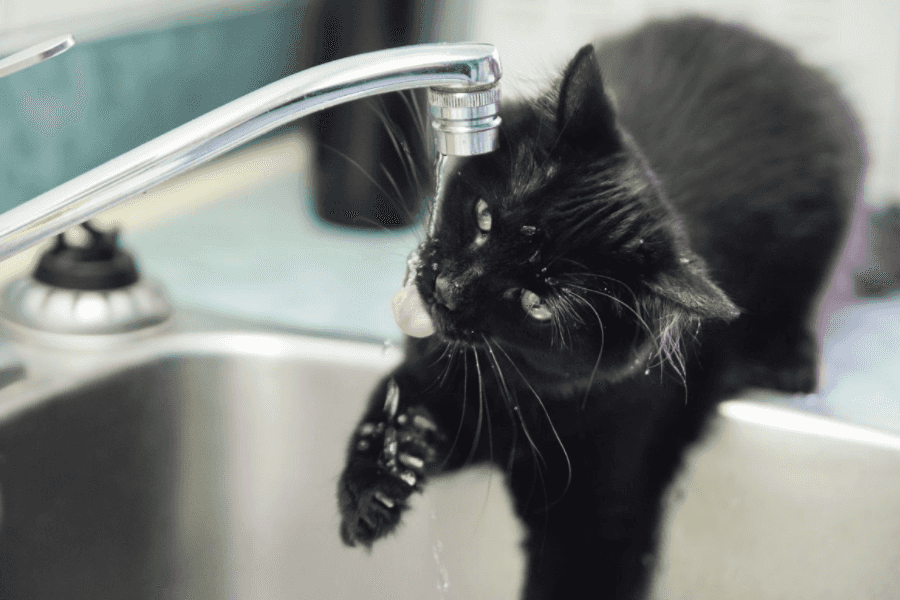Why Does Your Cat Act So Weird? Explained By Experts

Cats can be peculiar creatures. One minute they’re running around the house pouncing on anything that moves, and the next thing you know, they’re cowering inside that old pizza box that you were about to throw out. ![]()
But according to experts, there’s a scientific reason cats are such creeps, and it all comes down to their evolutionary history. Let’s dig in to understand the science behind some of the weird behaviors cats exhibit.
Why Do Cats Love High Places In Your Home?

Enabled by their unique muscular structure and keen balancing abilities, cats climb to high vantage points to survey their territory and spot prey in the wild. Your cat doesn’t need these particular skills to find and hunt down dinner in her food bowl today. But instinctually, viewing the living room from the top of the bookcase is exactly what she’s evolved to do.
Veterinarian Dr. Tony Buffington explains that in the wild, climbing to high vantage points helped cats scan their surroundings for potential prey and monitor their territory for threats. Although domesticated, pet cats retain this instinct to seek elevated perches.
So when your cat parks herself on top of your bookshelf or tall cat tree despite comfier options, she’s just following an ages-old survival technique — one that historically gave her species a leg up. You can try enticing her down with treats or toys, but climbing high will likely always be in her nature.
Why Do Cats Attack Small Objects In Your Home?

As predators, cats are opportunistic hunters. In the wild, they needed to hunt and eat small prey like mice, lizards, and birds multiple times a day to survive. This stalk-pounce-kill-eat strategy was key to getting enough calories.
According to Dr. Buffington, this evolutionary drive explains why pet cats retain their strong prey drive towards smaller objects that mimic prey, even when well-fed. Your cat’s desire to chase and pounce on balls, cat toys, feet under blankets, or anything that triggers her hunting instincts comes from millions of years of feline ancestors honing these skills.
While amusing, this behavior can lead to injuries or destruction in your home. Try wearing out your cat’s hunting urges with interactive play sessions using appropriate toys. Rotating toys keeps things exciting. This provides a healthy outlet for her instincts.
Why Do Cats Peer Into and Squeeze Into Tiny Spaces?

In the wild, small prey would hide in tiny nooks and crannies to avoid larger predators like cats. One explanation for your cat’s desire to poke her head in bags, boxes, and other openings is that she feels compelled to investigate these potential prey hideouts. This curiosity helped her wild ancestors successfully hunt.
Cats also love to tuck themselves into small spaces, especially when sleeping. This goes back to their dual role as predator and prey in nature. As hunters, confined spaces provided cover for cats to wait in stealth mode before striking their targets. As potential prey, small hideouts helped cats feel safe from larger carnivores looking for a meal.
So next time you find your cat squeezed into a tiny box or curled up in the back of a drawer, remember she’s just following instinct! Provide your cat with safe spaces she can occupy to satisfy this primal urge.
Why Do Cats Sharpen Their Claws On Your Furniture?

In the wild, cats relied on sharp claws for essential survival activities like climbing, hunting, and self-defense. Regularly sharpening their claws on nearby surfaces kept them conditioned and razor-ready.
Veterinarian Dr. Marty Becker explains that when your cat shreds your couch, curtains, and other household items, she isn’t acting out of spite. Sharpening her claws helps stretch her back and leg muscles while relieving stress. It’s simply an instinctive maintenance behavior passed down from her ancestral roots.
Provide appropriate scratching surfaces like scratching posts and cardboard scratchers to divert this damage. But keep in mind that scratching is a natural feline behavior you can’t entirely eliminate. Trimming her nails regularly also helps reduce harm to your home.
Why Do Cats Hide In Unusual Places When Scared?

You’ve likely experienced your cat darting under the bed or squeezing behind the toilet at loud noises like thunder or vacuums. This unnerved reaction relates back to cats being prey as well as predator.
According to Jackson Galaxy, cat behaviorist, cats feel safest when tucked into small spaces that provide cover. Their wild ancestors hid in crevices and burrows to avoid larger predators. This instinct persists in domestic cats exposed to anything frightening.
While funny, this knee-jerk escape response ensures your cat feels protected. Maintain her trust by gently easing her out of hiding once the scariness passes. Comfort and playtime help counter her fear. And maybe run noisy appliances when she’s elsewhere.
Why Do Cats Nap So Much Each Day?

Your lazy feline friend seems to spend more time snoozing than awake some days. But those epic cat naps lasting over 15 hours aren’t simply because she’s mastered relaxation. Frequent sleep is another survival tactic.
Jackson Galaxy explains that cats developed polyphasic sleep patterns in the wild. This means sleeping for short periods multiple times a day rather than one long nightly sleep. Staying highly alert to threats required resting in quick bursts to recharge while minimizing vulnerability.
So your cat’s impulse to conk out for a 3-hour power nap doesn’t mean she’s bored. She’s just yielding to an instinct that historically kept her ancestors safe. Let your cat follow her own natural rhythms rather than forcing her to conform to your schedule.
Why Do Cats Bring You “Gifts” of Dead Animals?
Nothing like waking up to find a dead mouse on your pillow as a “gift” from your beloved cat! But as gross as you may find these offerings, it comes from a good place in your cat’s predatory heart.
Jackson Galaxy explains that cats view these morbid presents as them generously sharing the spoils of their hunt with you. They don’t understand that you likely have zero interest in dead rodents and birds as snacks.
As natural hunters, your cats’ instincts drive them to kill small prey even when well-fed on kibble. By leaving these gifts for you, cats are essentially saying, “Look what I caught for us!” Take it as a compliment, even if the delivery method is less than ideal.
Keep your cat indoors to protect local wildlife. And resist scolding kitty for just following her instincts. Gently discard the deceased gift out of her view.
Why Do Cats Lick Your Hair and Face?

Getting an early morning face licking from a sandpapery cat tongue is a special kind of alarm clock experience. But why do cats insist on grooming us with their rough licks?
According to Dr. Buffington, when cats lick you, it reflects their social grooming tendencies. In the wild, cat mothers lick their kittens to clean them. Grooming reinforces social bonds between cat friends. So by licking you, your cat is showing her affection while treating you like family.
Your cat may also see your ungroomed hair as an invitation to tidy it up a bit with her raspy tongue. Surely you’ll appreciate her helpful efforts! Just try not to wince at the feeling. Think of it as the price of love from your quirky companion.
Why Do Cats Knead You With Their Paws?
That blissful purring combined with vigorous paw kneading may seem like your cat’s ultimate gesture of happiness. But why do cats attack your lap, bed, or arms with those serial kneading motions?
According to Dr. Becker, kittens knead their mother’s belly to stimulate milk production during nursing. The motion stuck even after cats grew up. For adult cats, kneading is a self-soothing behavior that channels energy. It often happens alongside other joyful activities like eating and purring.
So take those loving jabs from your cat’s kneading as a compliment! She associates you with comfort and contentment. Provide soft blankets that satisfy your cat’s kneading needs without shredding your skin. Consider it a fair trade for such a devoted cuddle buddy.
Why Does Your Cat Drink From The Faucet?

You may have experienced your cat’s strange insistence on drinking directly from the faucet rather than her perfectly good water bowl. What’s up with that faucet obsession?
Jackson Galaxy explains that running water from the tap seems fresher and more appealing to cats. Their ancestors preferred drinking from moving streams rather than stagnant ponds vulnerable to contamination. This instinct persists in picky modern cats.
Additionally, cats are very reliant on their sense of hearing to find water sources. The audible flow of faucet water better grabs their attention than still bowl water. And finicky cats may dislike having their whiskers brush the bowl edges.
Satisfy your cat’s finicky preferences by providing a circulating water fountain. This mimics the motion and sound of faucets without the plumbing hassle. It’s a weird quirk, but catering to it means better hydration for kitty.
Why Do Cats Freak Out Around Cucumbers?
One of the most bizarre feline phobias involves the fear of cucumbers. Videos abound showing terrified cats fleeing from the oblong green veggie suddenly placed behind them. What is it about cukes that strikes fear into the hearts of cats?
According to Dr. Buffington, the reaction likely stems from cats’ startle reflex more than an actual phobia. Their vigilance against potential predators makes them prone to alarm at any unexpected object suddenly appearing in their peripheral vision.
A harmless cucumber can trigger the same swift panic reaction as a snake or other menace might in the wild. The reaction reflects cats’ hair-trigger instincts to run first, identify later. So go easy on cucumber pranks with your neurotic kitty! Their reaction is just evolutionary hard-wiring at work.
Conclusion
Understanding the evolutionary basis for your cat’s weird behaviors can help you be more tolerant and improve your relationship. Avoid scolding them for natural instincts.
Instead, try redirecting the behaviors or providing appropriate outlets. Most importantly, appreciate the peculiarities that make cats such charming companions! ![]()
Tags
Share
Table Of Contents
Related Posts
Quick Links

